Research into litter and fly-tipping at motorway car parks

Objective
In 2018, Mooimakers and the Agency for Roads and Traffic (AWV) commissioned some research into the impact of various measures on litter and fly-tipping at motorway car parks and at other nearby locations to determine whether or not there had been any shifts in the issue. The measures were assigned such that the study could answer the following question: "What measures can we use to address the abandonment of litter and fly-tipping (in the rubbish bin, dumping, and side yards) at motorway car parks?"
Location
Ten motorway car parks were selected, these being in Waasmunster, Diepenbeek, Hoeselt, Postel and Halle, in both directions in each case. With the exception of the Halle motorway car park towards Charleroi – which served as the reference car park – one or more measures were implemented at each motorway car park. In each case, these are AWV-managed car parks without a concession (i.e. without a petrol station or other facilities, such as a store or eatery). To ascertain whether or not there is a shift of fly-tipping waste to one or more locations near the respective motorway car parks, one or more hotspots were also identified and monitored for each car park.
Measures
The researchers implemented one or more of the following measures at each motorway car park:
-
Installation of semi-underground rubbish bins with a volume of 1,500 litres, equipped with the necessary signage. The existing 120-litre rubbish bins were removed.
-
Placement of additional signage consisting of an additional sign (arrow) to the location of the semi-underground rubbish bin (see photo)
-
Placement of a single large "You are being watched!" sign at the entrance to the car park
-
Placement of a small "You are being watched!" sign above each rubbish bin
-
Placement for selective collection of PMD
No action was taken at nearby hotspots.
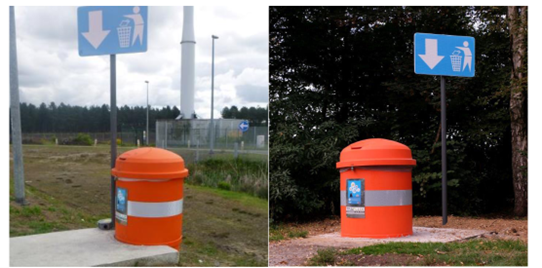
Photo : Semi-underground rubbish bin with signage board with down arrow
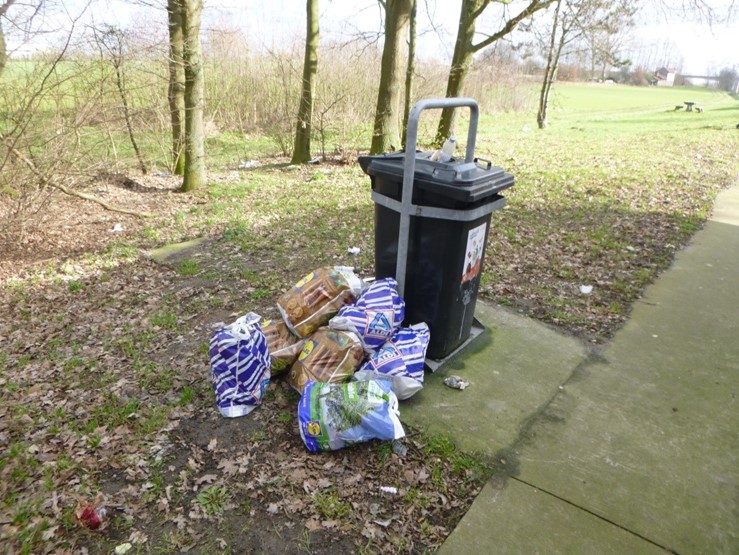
Measurements
Three baseline measurements and three intervention measurements were conducted at each motorway car park and hotspot. The baseline measurements were conducted between 31 January 2018 and 14 March 2018, and the intervention measurements were conducted between 26 April 2019 and 20 September 2019. The research report was delivered in September 2020.
During the initial baseline measurement, a perimeter with a radius of a maximum of two metres was established for every rubbish bin individually. This surface area was subsequently maintained during all the following baseline and intervention measurements.
The following waste fractions were recorded at the motorway car parks:
Around the rubbish bin:
-
Number of cigarette butt items
-
Number of 'fresh' chewing gum items
-
Other litter
-
Fly-tipping litter
In the rubbish bin:
-
Properly disposed truckers' waste
-
Properly disposed waste
-
Fly-tipping litter
At the hotspots, a walking route of 100 to 300 metres was recorded during the first baseline measurement. Since no shift regarding litter is anticipated, only the fly-tipping litter was analysed at the hotspots, both in the rubbish bins and along the defined walking route. Litter was not monitored at the hotspots.
Result
The placement of semi-underground rubbish bins proved to be the most effective measure against dumping household waste in the rubbish bin and fly-tipping besides the rubbish bins at motorway car parks. These measures resulted in an estimated proportional decrease of 111%, which corresponded to an estimated 186.5 kg less fly-tipping waste around the rubbish bin, per day, per motorway car park.
The quantity of litter in the immediate vicinity of the rubbish bin also decreases significantly, i.e. 66% less litter, corresponding to 6.2 kg less litter around the rubbish bin.
There was no noticeable shift in fly-tipping to the surrounding hotspots.
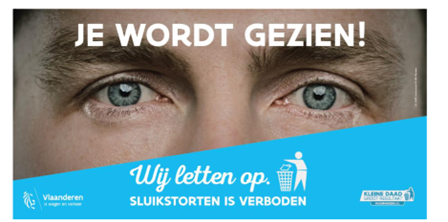
Image : Sign with eyes against fly-tipping
Placing additional signage (arrow to the right) or a small "you will be seen!" sign at each rubbish bin as an individual measure does not significantly reduce litter or fly-tipping. Combining these individual measures with the placement of semi-underground rubbish bins does result in a significant decrease.
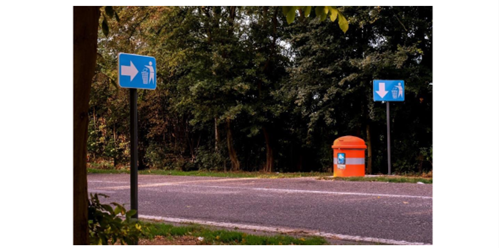
photo: Additional signage board with an arrow pointing to the right for further clarifying the location of the rubbish bin
The contents of the PMD rubbish bins were sorted to get a picture of the quality of the PMD collected. These analyses showed that one-third of the PMD collected consists of properly disposed PMD; two-thirds consists of residue.
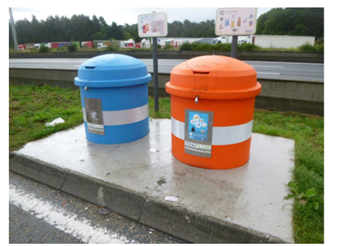
Photo : Semi-underground rubbish bins for selective collection
Cost-benefit analysis
Since placing semi-underground rubbish bins has a pronounced positive effect on the quantity of litter and fly-tipping in and around the rubbish bin, a cost analysis was also conducted to determine the (potential) payback period. This showed that collection frequency is the decisive parameter in the cost analysis. Thus, by maximising the collection frequency, placing semi-underground rubbish bins may be more cost-effective. One way to do this is to coordinate collection with the filling rate for the semi-underground rubbish bins at the motorway car park.
Conclusion
The placement of semi-underground rubbish bins is the most effective measure against dumping in the rubbish bin and fly-tipping besides the rubbish bins at motorway car parks. The quantity of litter in the immediate vicinity of the rubbish bin also drops significantly. Placing semi-underground rubbish bins can be cost-effective in the long term, albeit only if the collection frequency is optimised. Adding an additional arrow (to the right) and/or a sign with small eyes may have a reinforcing effect.